|
IBCA
Supply Chain Foundation Guide (SCF)
4.
Understanding The GS1 System
(rev
December 2011)
4.1
Introduction
People and organizations
communicate better when they both use the same words and numbering systems. In
language, standard words are defined in the dictionary. For measurement, the
metric system is an international standard. The GS1 System is an internationally
accepted method of identifying products, serializing shipping containers and
clearly communicating other important business transaction data such as purchase
order numbers, expiration dates, lot numbers, etc. in a standard, machine
readable (bar code) format.
The GS1 System (Originally
referred to as EAN.UCC System with EAN being European Article Numbering and UCC
being Uniform Code Council) has been used since 1974 in the food industry but
nothing restricts its use in non-food industries. In fact, the GS1 System was
originally conceived and developed by members of the electrical products
industry for use between manufacturers and distributors. In the United States
alone, over 500,000 manufacturers of everything including industrial, general
merchandise, food and of course IBCA products are using this product numbering
system.
Understanding the concepts
of the GS1 System is important to the success of the compliance labeling
project, so take your time reading and digesting this chapter before going on to
the rest of the book.
This chapter is organized into the following sections:
4.2 Overview of the GS1 System, Sunrise 2005 and GTIN
The objective of the GS1 System is to improve communication
between trading partners by establishing a precise but flexible method of
uniquely identifying products and package quantity in both human readable and
machine readable formats. The GS1 published updated requirements for product
numbering called Sunrise 2005. This was necessary to ensure that the system was
compatible with domestic and foreign goods. Sunrise 2005 does not change the
basic structure of the bar code number. It does require that the
data files
containing information about the product be redefined as a 14 position numeric
field. The file number is called a Global Trade Item Number (GTIN). To simplify
things just realize that the carton label always has been 14 digits, so with
carton quantities nothing changes. If you have originally assigned 12 digit UPC-A
number (now referred to as a GTIN-12) to the consumer unit, that GS1-128 bar
code has not changed either. However the GS1 is requiring the
data files containing GTIN-12 numbers be expanded to 14 digits by adding two zeros to the
leftmost positions of the data
field. The bar code does not change. It stays 12
digits long. The following is a brief overview of the GS1 product numbering
system.
-
There are rules for assigning Item
Reference numbers (GTIN-12) to individual items, called consumer units in GS1
terms. A consumer unit is the lowest saleable unit of sale for a specific
product. A single red pen, a 5-Pack, and a 10-Pack of the same red pen are three
different consumer units and would each get a different Item Reference number.
The Item Reference numbers assigned to "consumer units" are all numeric and the
length is determined by the Company Prefix that precedes it. The rules for
assigning them are explained later in this chapter under the section titled
GTIN-12 and Consumer Units.
-
There are also rules for assigning Item Reference numbers to
intermediate packs and shipping containers of consumer units. When identical
consumer units are packaged into standard quantities of intermediate packs or
shipping containers, GS1 specifies that they should be assigned a new, 14 digit
number (GTIN-14). Cases containing 100 individual red pens would be assigned a
different 14 digit number than cases containing 10 each, 10-Packs of the same
red pen. The rules for assigning these 14 digit numbers are explained later in
this chapter in the section title
GTIN-14 and Intermediate Packs.
-
There are also rules for assigning unique serial
numbers to cartons and shipping containers, like the Package Identification
Number (PIN) assigned by common carriers. This system is used in conjunction
with EDI (Electronic Data Interchange) to tie the container or pallet to a
specific purchase order number. The rules for assigning these are explained
later in this chapter in the section titled
SSCC
and Carton Serial Numbers.
-
There are also rules for
communicating secondary information such as purchase order numbers, batch
numbers, lot numbers, expiration dates, and other types of data commonly
communicated between trading partners. The format for these numbers varies, i.e.
not always a specific number of digits or letters, but the rules are precise and
allow the information to be encoded in a bar code for fast and accurate data
entry. The rules for assigning these numbers are explained later in this chapter
in the section titled NOTE:
GTIN-14 and Secondary
Information.
In addition to defining a standard method of assigning
Item
Reference
numbers, carton serial numbers and identifying secondary information, the
GS1 System also specifies which symbologies to use for each
different number. The table below describes which numbers to use on different
types of items and what symbologies to use.
|
Item Being Identified
|
Number
Format
|
Information
in the Bar Code
|
Symbology
|
|
Consumer Unit |
GTIN-12, 13 |
Trade Item Identification |
GTIN-12, 13 or 8 |
|
Groupings of individual
trade items above unit level (Intermediate, Carton or
Pallet) |
GTIN-14 |
Trade Item Identification |
ITF-14 or GS1-128 with
Application Identifier of "01" |
|
Transport (Logistic) Unit (Shipping Container) |
18 digit Serial Shipping
Container Code (SSCC). |
Serial number uniquely
identifying a shipping container, pallet, etc. |
GS1-128 with an
Application Identifier of "00" |
|
Other |
Length varies but the symbol
includes Application Identifiers to designate the type of data in the
bar code. |
Secondary information such
as purchase order number, lot number, etc. |
GS1-128 |
4.3
GTIN-12 and Consumer Units
The GTIN-12 Global Trade Item Number is a
twelve-digit number assigned by a manufacturer to individual "consumer units" in
its product catalog. For many, if not most manufacturers, it also becomes the
base number for identifying intermediate packs and shipping containers. No alpha
characters are allowed in the GS1 System used to identify products or serialized
cartons. Catalog numbers containing numbers and letters can still be carried in
the inventory file and printed on packages or labels. Different manufacturers
offering similar products DO NOT use the same GTIN-12, 13 or 8 number.
A "consumer unit" is the lowest level of packaging for a
given product. For example: consider two manufacturers of similar, if not
identical, red pens. Both manufacturers offer their red pens in singles and
5-Packs.
|
Item
|
Company
|
Product
|
Package Description
|
|
1
|
Manufacturer A
|
Red Pen
|
1 Red Pen
|
|
2
|
Manufacturer A
|
Red Pen
|
5-Pack of Red Pens
|
|
3
|
Manufacturer B
|
Red Pen
|
1 Red Pen
|
|
4
|
Manufacturer B
|
Red Pen
|
5-Pack of Red Pens
|
In the table above, Items 1
& 3 are similar products in identical package quantities but since they are
manufactured by different companies, they would have different GTIN numbers. The
GS1 System does not require that all Red pens should have the same item number.
As mentioned earlier, the
GS1 has made some changes to the numbering system so it is truly global. One
change is the number of digits in the Item level bar code that is read at the
point of sale. In North America, this always had been a 12 digit number.
However, in other parts of the world the item level bar code is 13 digits. In
the future, POS scanners will see more of the 13 digit bar codes. To keep the
explanations simple, since most of the companies in the IBCA supply chain are
already using the 12 digit item numbers, we will not address the 13 digit
numbers here. So, for companies who have assigned and printed GTIN-12 digit
numbers, nothing will change.
Items 1 & 2 above are the
same product made by the same company but they are different package quantities.
In GTIN terms, each of these different package quantities is called a "consumer
unit" and would be assigned a different GTIN-12 digit number and, when presented
in a data file would have two leading zeros added so it would become a 14 digit
GTIN. Since the GS1 is the globally recognized organization we are going to
refer to the original UPC-A 12 digit number as the GTIN-12. But it is the same
thing. The GTIN-12 is divided into three sections structured as follows:
-
The first section consists of a prefix of digits that is
assigned to individual companies by the GS1. No two companies are assigned the
same GS1 Company Prefix. To date, approximately 250,000 numbers have been
assigned. Instructions for obtaining a GS1 Company Prefix are at the end of this
chapter.
-
The second section consists of the Item Reference number that
each individual company assigns to its products. The length is determined by the
GS1 Company Prefix that precedes it.
In
accordance with the GS1 System, manufacturers assign different Item Reference
numbers to every consumer unit. Using the red pen example above, an Item
Reference number would be assigned to a single red pen and a different Item
Reference number to 5-Pack of the same product.
The result is a twelve digit number that uniquely identifies
the manufacturer and a specific item or product.
Example
GTIN-12 that could be assigned by the manufacturer to a Red Pen
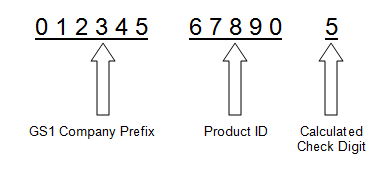
The GS1
Specification specifies that GTIN-12 data structure (formerly UPC-A) and GTIN-8
(formerly UPC-E) be encoded like this:
|
GTIN-12 |
GTIN-8 |
|

|
 |
Note: GTIN-8 is a special version of the GTIN-12 that reduces
the 12 digit number to 8 digits using specific rules. It is used to mark small
items and it is only available to companies whose GS1 Company Prefix starts with
a zero (0).
Note:
The GTIN-13 is fundamentally the same as the GTIN-12. The GTIN-13 contains 13
digits. Companies who have been issued a GS1 Company Prefix do not need to
reapply if dealing outside the United States.
Whether the
number above is entered from the keyboard or scanned with a bar code scanner,
the computer finds the record for the consumer unit of one pen from this
specific manufacturer.
4.4
GTIN-14 and
Intermediate Packs
GTIN-14 (used in ITF-14, GS1-128
(formerly UCC/EAN-128), Reduced Space Symbols (now called Databar), and Data
Matrix bar codes, plus EPCs) primarily relate to 14 digit numeric fields (either
numbers and / or bar codes). One digit representing the Indicator digit to
indicate packaging level, twelve digits the GS1 Company Prefix and the Item
Reference assigned by your company.
As mentioned
earlier, if they are both zeros the number would be the global trade item number
(GTIN) for the consumer unit. If the leading number is greater than a zero it is
still a GTIN but it is also the number that identifies intermediate packs and
shipping containers holding standard configurations of consumer units. The 14
digit number, displayed in a bar code is typically called the shipping container
code (SCC) but because that sounds so much like the former SSCC we now call it
the GTIN-14 because of the expanded definition.
Continuing with the pen example,
consumer units of one pen might be boxed by one manufacturer in two standard
configurations: cartons containing 500 individual pens and cartons containing
750 individual pens. These are two different package levels for the same
consumer unit.
Using the GS1 System, the carton
containing 500 would be assigned an indicator digit (package level) of "1" (for
example) and the carton containing 750 would be assigned an indicator digit
(package level) of "2." (for example) Customers could now order individual pens
in cartons containing 500 or 750 individual pens to the carton.
Example of 14 digit
GTIN-14
GS1 Company Prefix =
012345
Item Reference = 67890
10012345678902
= 1 carton containing 500 individual pens
20012345678909
= 1 carton containing 750 individual pens
The package
level is communicated in the first digit (indicator digit). The indicator digit
of "1" doesnít always mean a quantity of 500 consumer units and the indicator
digit of "2" doesnít always mean 750 consumer units.
Indicator
digits can mean different quantities for different products. The zero (0)
following the Indicator digit is automatically added for all North American
packages. The original UCC-12 number is the same because it refers to the same
consumer unit of one individual pen. The check digit at the end is recalculated
based on the previous 13 digits.
The shipping
container standard specifies that the GTIN-14 can be encoded in the Interleaved
2 of 5 symbology (ITF-14) or the GS1-128 symbology. Both symbologies are shown
below.
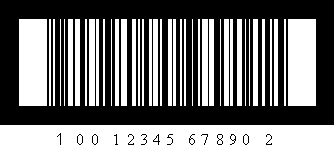
Chapter 5: Implementing a GTIN Labeling Project
explains how to implement a customer request for
both the GTIN-12 and the GTIN-14 described above.
At the option of the trading partners, the GTIN-14 can also
be encoded in the GS1-128 Symbology using an Application Identifier (AI) of
"01". With this option, the SCC shown above would now be coded as follows using
GS1-128.

The number
above is interpreted by the computer as the GTIN-14 number. The (01) in the
beginning of the number is an application identifier used to signify that the
GS1-128 bar code contains the GTIN-14. The check digit at the end is based on
the previous 13 digits (does not include the AI of "01"); hence, the GTIN-14 is
the same regardless of symbology.
4.5 Carton Serial Numbers
The GS1 System
also defines a method of serializing cartons (Serial Shipping Container Code or
SSCC), so the contents can be traced to a specific line item (or items) on a
specific purchase order. The standard format for serializing cartons and
shipping containers is an 18 digit number encoded in GTIN-14 symbology shown in
the following illustration. The (00) is the AI for the SSCC. This number may or
may not appear on the same label used for product identification and is not
generally added to the box or container until the time of shipment.

Serial numbering of cartons provides
unique identification. This is important, especially to identify cartons
containing variable quantities or non-standard mixtures of product and as a
reference number for EDI (Electronic Data Interchange) transactions. When used
in conjunction with EDI, serial numbering cartons and shipping containers
eliminates the need to physically inspect the contents of every carton.
Eliminating this procedure has improved the productivity of some warehouse
receiving operations by 100% or more!
The Serial
Shipping Container Code (SSCC) is different from the GTIN-14 assigned to
intermediate packs and shipping containers of consumer units. The same GTIN-14
is assigned to all identical packaging configurations of the same product. The
Serial Shipping Container Code (SSCC) is a unique number assigned to each carton
as it is shipped. Because it is unique, it can be used as a reference number
tying the contents of a specific carton to information about the shipment
including the purchase order(s) it should be applied to, carrier, date of
shipment, etc. It is used in conjunction with the EDI 856 Advance Shipping
Notice (ASN).
The 18 digit number consists of
the following items:
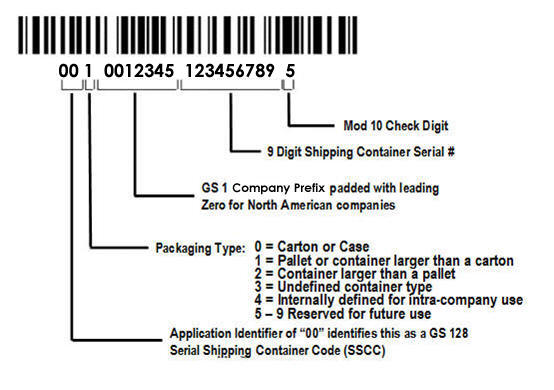
Chapter
6: Implementing a Serial Shipping Container Project
explains how to implement a customer request for this numbering system.
4.6 Product ID versus
Shipping Labels
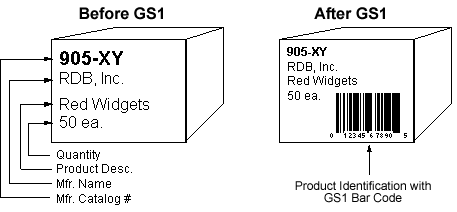
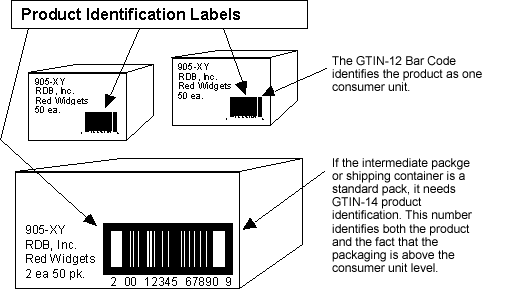
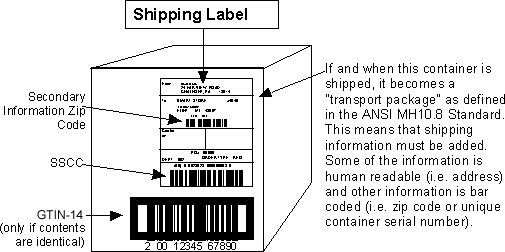
4.7
GTIN-14 and Secondary Information
In addition to
defining standard methods of identifying products and serializing cartons and
shipping containers, the GS1 standard also defines a method of identifying other
important types of data with a bar code. For example:
-
Purchase Order Number
-
Production Date
-
Destination Postal Codes
-
Batch Number
-
Lot Number
-
Expiration Date
Bar codes
containing secondary information are encoded in the GTIN-14 symbology and
include prefix codes, called Application Identifiers (AI's), to designate the
type of data they contain. For example, the serial shipping container code
contains the AI of "00" to indicate that the bar code contains a serial shipping
container code. A bar code containing a purchase order number would start with
the AI of "400." Bar codes containing batch numbers start with the AI of "10."
Application
identifiers can be used by the computer system to automatically read many bar
codes and place them in the proper fields in a database. AIís will be used
extensively with some ANSI MH10.8 labels (the basis for the label found on the
shipping container).
4.8 Getting a GS1 Company Prefix
When a GTIN
number is needed (whether the company manufactures or packages a product),
companies should contact the GS1 to get a uniquely assigned Company Prefix. GS1
assigns Company Prefixes and maintains a database assuring that no other company
is assigned the same number. Applicants should contact GS1 and request an
application form. Their address and phone number is shown below:
The GS1 US Customer Service Team
provides a single point of contact for all member support activities. As the
"front line" of support for GS1 US members, Customer Service Representatives
answer questions about a variety of GS1 US related issues, such as, the process
of obtaining a GS1 Company Prefix (used in developing a UPC-A bar code), GS1
System standards, educational programs, and education products as well as a
variety of general interest questions. The GS1 US Customer Service Team can be
reached Monday through Friday from 8:00 AM to 6:00 PM EST.
4.9 Summary of the
GS1 System
The GS1 System assigns company
prefix numbers from which the company defines different product identification
numbers to their individual "trade items". Consumer units are assigned a
12-digit number. Packaging levels above the consumer unit are assigned a
14-digit number.
Consumer units are defined as the
smallest unit intended to be sold to the ultimate end user. A single red pen and
a 5-count pack of red pens are considered different consumer units.
Trade items above the consumer unit
may be intermediate packs, cartons, packs containing multiple consumer units or
standard mixtures of consumer units. A carton containing 4 reams of paper is an
intermediate pack. A carton containing 12 of the same reams of paper is another
intermediate pack. These are two different inventory keeping units or trade
items.
The standard also defines how to
assign serial numbers to shipping containers. This GTIN-14 Serial Shipping
Container Code (SSCC) uniquely identifies shipping containers and provides a
method of linking the physical carton or shipping container to information about
its contents. The SSCC is an 18-digit number preceded by AI "00".
Finally, the standard also defines a
method of identifying secondary information such as purchase order numbers,
expiration dates, etc. either for internal uses or on the ANSI MH10.8 label.
By using a standardized numbering
system, manufacturers donít need to maintain a different item number file for
each customer that buys that product. Distributors and retailers can use the GS1
System to place orders, automate receiving and maintain inventory counts by
scanning the GTIN-12 bar code on individual items and the GTIN-14 (ITF-14 or
SSCC 18 digits) bar code on cases and cartons.
Using
the GS1 System with Existing Internal Numbers
If desired for
internal purposes, individual companies may also continue to use their own
proprietary number for any purpose other than communicating with an independent
trading partner. This is done by using an "alternate" part number field in the
inventory or part number database. This enables the use of either GTIN-12 (UPC-A)
or existing proprietary number.
4.10 Additional Reading on the
GS1 System
-
GTIN-12 (UPC-A)
Symbol Specification
-
Application
Standard for Shipping Container Codes
-
GTIN-14
Application Identifier Standard
-
GS1 Symbol
Placement Guidelines
-
Apparel
Guidelines: Format and Symbol Placement
-
GS1 Quality
Specification for the GTIN Printed Symbol
-
General GTIN
Specification
-
GS1 Solutions
Center
These
materials are available from the GS1at 1-937.435.3870 or visit their web site at
www.gs1us.org.
BACK TO TOP
|